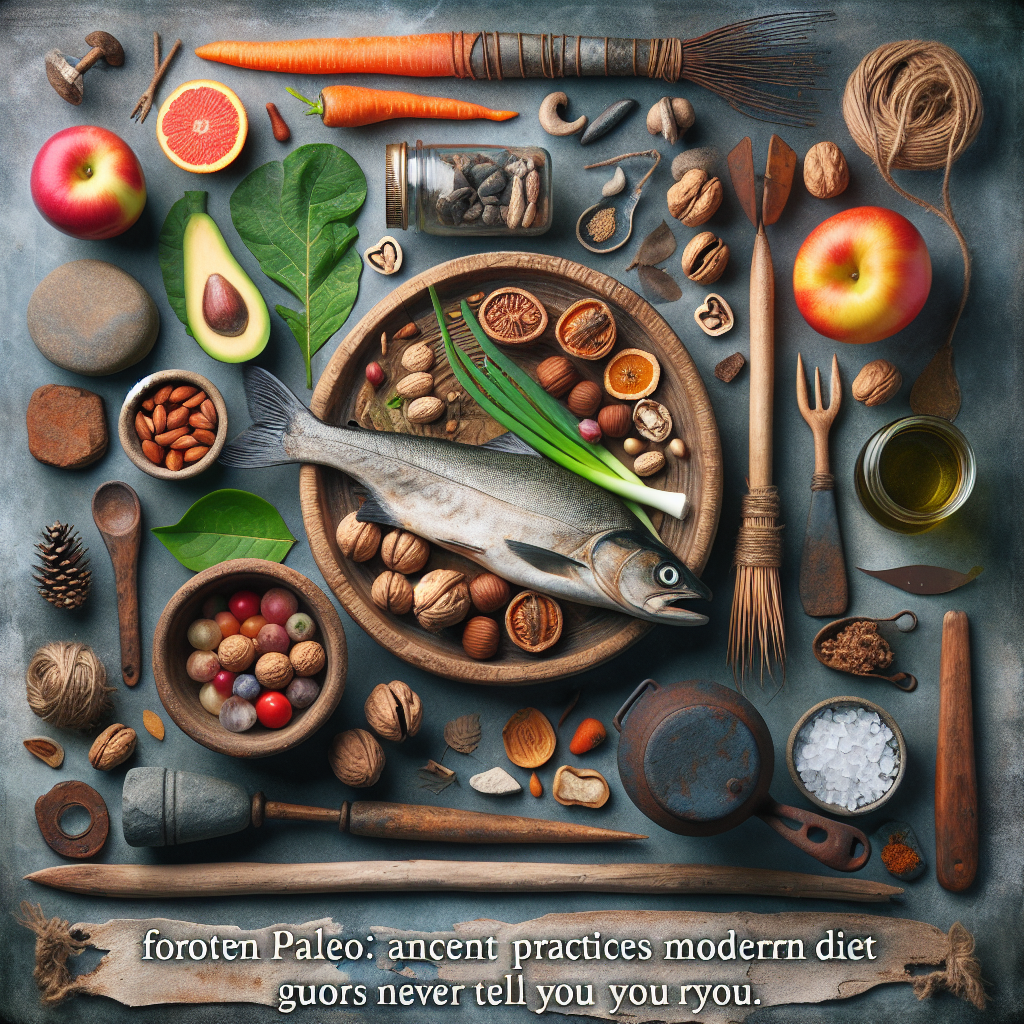
Rediscovering the Forgotten Paleo Lifestyle
Over the past decade, the Paleo diet has surged in popularity, with health influencers and enthusiasts advocating a return to ancestral eating. The idea is simple: eat like early humans by prioritizing whole foods such as meat, fish, vegetables, fruits, nuts, and seeds, while avoiding processed foods, added sugars, grains, and dairy products.
While this approach has helped many people improve their health, it often overlooks the broader lifestyle habits that contributed to our ancestors’ vitality. Welcome to the “Forgotten Paleo”—a deeper dive into the ancestral strategies beyond the plate. From communal eating practices to natural movement and circadian living, incorporating these often-ignored elements of ancient life can help rebuild lasting wellness in a modern world.
Shared Meals and Spiritual Connection: Nourishing the Body and Soul
The typical image of the Paleo diet often focuses on what is consumed, but in traditional societies, meals were communal, spiritual events. Food wasn’t just fuel—it was shared, blessed, and eaten in a collective, peaceful setting.
Research published in Physiology & Behavior confirms that eating in a group can reduce stress hormones like cortisol and boost digestion. This is because digestion is tied to our parasympathetic nervous system—the calming mode our bodies activate when we’re at ease.
For example, the Hadza people of Tanzania, a contemporary hunter-gatherer tribe, regularly eat together around a fire, reflecting on the day’s activities and expressing gratitude before consuming any food.
Dr. Elissa Epel, a health psychologist at the University of California, San Francisco, explains, “Eating mindfully and in community helps stimulate the body’s rest-and-digest response, supporting optimal nutrient absorption.”
Takeaway: Turn meals into meaningful experiences by ditching the screens and distractions. Share food with family and friends, eat at the table, and practice gratitude before each meal. This habit reconnects us with the social roots of nourishment—a fundamental part of ancestral health.
The Power of Intermittent Scarcity: Embracing Natural Fasting Rhythms
In contrast to today’s structured fasting protocols like 16:8 or 5:2, ancient humans fasted naturally based on food availability. Sometimes they feasted; other times, food was scarce.
This unpredictability turned out to be beneficial. A study published in Cell Metabolism highlights that intermittent fasting supports metabolic health, longevity, and immune function by stimulating cellular repair processes such as autophagy—the body’s way of replacing damaged cells.
Dr. Valter Longo, director at the Longevity Institute at USC, notes, “The human body evolved to thrive on metabolic flexibility, shifting between fed and fasted states. Our ancestors didn’t follow strict three-meal-a-day routines—and we don’t have to either.”
For example, ancient communities might celebrate a bountiful harvest with a feast, only to face several lean days afterward. This fasting rhythm helped regulate weight and increase insulin sensitivity over time.
Takeaway: Adapt your eating habits to reflect ancestral patterns. Try skipping a meal occasionally when you’re not hungry, or allow a longer fast once a week. Let your hunger guide you, not the clock. This variability mirrors the erratic food supply of early humans and can lead to improved metabolic function.
Reintroducing Wild Foods: Boosting Gut Diversity Naturally
Today’s Paleo menus often feature a narrow range of “safe” vegetables—spinach, kale, and sweet potatoes being the usual suspects. But our ancestors thrived on wild, diverse plants that rotated with the seasons.
A study in Nutrients shows that wild plants contain far more antioxidants and medicinal properties than their domesticated relatives. Wild greens such as purslane and amaranth offer greater concentrations of omega-3s and essential micronutrients.
More importantly, diet diversity promotes a healthy gut microbiome. According to the American Gut Project, microbial diversity in our intestines is directly connected to better immunity, mood, and metabolic performance.
Dr. Tim Spector, a professor of genetic epidemiology at King’s College London, states, “The wider the variety of food, especially natural fibers, the healthier our gut. This variety likely contributed to the lower rates of allergies and autoimmune issues seen in traditional cultures.”
Takeaway: Broaden your plant intake. Add wild or less common greens like dandelion, nettle, or wild ramp to your meals—safely foraged or sourced locally. Rotate your vegetables and avoid eating the same types repeatedly. Joining a community-supported agriculture (CSA) program is a great way to experience year-round biodiversity.
Ancestral Movement: Make Life Your Workout
Today’s exercise is often confined to hour-long sessions at the gym. But our ancestors moved constantly and purposefully. They walked miles daily, climbed trees, squatted, lifted natural objects, and engaged in playful activity.
According to the Journal of Clinical Medicine, steady, low-intensity physical movement—like walking, carrying items, or even manual chores—offers more sustainable cardiovascular benefits than short bursts of high-intensity workouts.
Biomechanist Katy Bowman, author of Move Your DNA, explains, “Natural movement encourages balance, coordination, and functional strength. These patterns are what kept our ancestors agile and pain-free.”
Examples include play-fighting, dancing, and persistence hunting—physically demanding yet unstructured movements that were part of daily life.
Takeaway: Sprinkle movement throughout your day. Go for regular walks, carry groceries instead of using a cart, take the stairs, or squat down while working. Living actively doesn’t require a gym—it requires intention.
Sunlight and Circadian Rhythms: Resetting Your Biological Clock
Before artificial lighting and digital screens, the sun set humanity’s schedule. Early humans received consistent natural light during the day and experienced darkness in the evenings, allowing their body clocks to stay aligned with natural rhythms.
Sunlight is vital for synthesizing vitamin D, which supports immune health, mood, and bone strength. However, over 40 percent of American adults are vitamin D deficient, according to the CDC.
Inconsistent light exposure and late-night screen use disrupt the body’s circadian rhythms. Research published in The Lancet Oncology links this misalignment to sleep disorders, hormonal imbalances, and even increased cancer risk.
Dr. Satchin Panda from the Salk Institute emphasizes, “Aligning your activities and sleep cycles with natural light signals supports hormone balance and cellular repair.”
For example, our ancestors would rise at dawn, spend most of their day outdoors, and wind down at dusk. Firelight or darkness cued the body’s natural urge to sleep.
Takeaway: Make sunlight your alarm clock. Expose yourself to early morning light, reduce screen time in the evening, and prioritize sleep by dimming your environment after sunset. Experiment with outdoor weekends to realign your body with the earth’s rhythm.
Integrating a True Paleo Lifestyle
While the modern Paleo movement has helped many rediscover the power of whole foods, a truly ancestral approach goes beyond what’s on the plate. Lifestyle factors like communal meals, fasting patterns, wild food diversity, functional movement, and alignment with natural light are vital to overall wellbeing.
These often-overlooked pillars of primal living can enhance sleep, immunity, mental clarity, and emotional balance. Embracing even a few of these habits can offer noticeable improvements in your daily health.
Pro Tip: Start small and intentional. Choose one ancestral habit—perhaps eating with loved ones or taking a morning walk in sunlight—and build from there. Reclaiming your health doesn’t require perfection—just presence and persistence.
In a world overflowing with screens, stress, and processed foods, returning to our roots might be the most radical wellness strategy of all. Tiny steps toward ancestral living can lead to big changes in how you feel, move, and live.
References
– Epel, E., et al. “Stress, Eating, and the Relaxation Response.” Physiology & Behavior, 2014.
– Longo, V. “Fasting and Molecular Mechanisms of Aging.” Cell Metabolism, 2015.
– Sonnenburg, J. et al. “Starving the Microbiota: Diet and the Microbiome.” Nature Reviews Microbiology, 2016.
– Centers for Disease Control and Prevention (CDC). Reports on Vitamin D Deficiency, 2011–2014.
– Loef, M., and Walach, H. “Sunlight Exposure and Cancer Risk: Nature’s Medicine?” The Lancet Oncology, 2014.
– Spector, T. “The Diet Myth.” Weidenfeld & Nicolson, 2015.
– Bowman, K. “Move Your DNA: Restore Your Health Through Natural Movement.” 2014.
– Panda, S. “The Circadian Code.” Rodale Books, 2018.
– American Gut Project: Microbiome Research Findings.
For trusted solutions to support your holistic health needs—from sleep and hormone regulation to appetite control—explore our curated offerings at edrugstore.com. Take the next step in your journey to reclaim your ancestral vitality.


